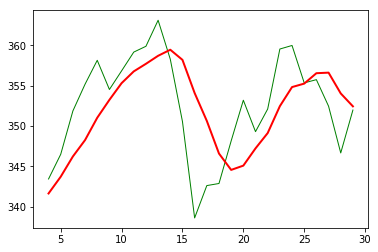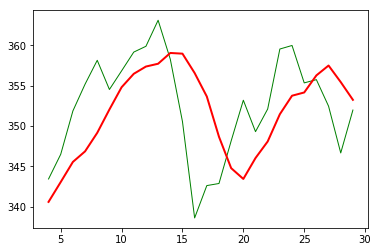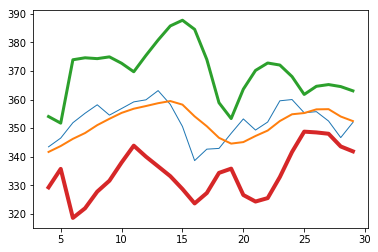真实波动幅度均值-主要演示maximum函数
# In[1]:
import numpy as np
# In[2]:
h,l,c = np.loadtxt('data/data.csv',delimiter=',',usecols=(4,5,6),unpack=True)
# In[3]:
#ATR 基于N个交易日的最高价和最低价进行计算,通常取近20个交易日
N = 20
h = h[-N:]
l = l[-N:]
# In[4]:
#前一个交易日的收盘价
previousclose = c[-N-1:-1]
# In[5]:
#h-l 当日股价范围
#h-previousclose 当日最高价与前一日收盘价之差
#previousclose - l 前一日收盘价与当日最低价之差
# In[6]:
truerange = np.maximum(h-l,h-previousclose,previousclose-l)
# In[7]:
print truerange
# Out[7]:
[ 4.26 2.77 2.42 5. 3.75 9.98 7.68 6.03 6.78 5.55
6.89 8.04 5.95 7.67 2.54 10.36 5.15 4.16 4.87 7.32]
# In[8]:
atr = np.zeros(N)
# In[9]:
atr[0] = np.mean(truerange)
# In[10]:
for i in range(1,N):
atr[i] = (N-1)*atr[i-1] + truerange[i]
atr[i] /= N
# In[11]:
atr
# Out[11]:
array([ 5.8585 , 5.704075 , 5.53987125, 5.51287769, 5.4247338 ,
5.65249711, 5.75387226, 5.76767864, 5.81829471, 5.80487998,
5.85913598, 5.96817918, 5.96727022, 6.05240671, 5.87678637,
6.10094705, 6.0533997 , 5.95872972, 5.90429323, 5.97507857])简单的移动平均线
# In[12]:
N = 5
weights = np.ones(N)/N
print weights
# In[13]:
c = np.loadtxt('data/data.csv',delimiter=',',usecols=(6,),unpack=True)
# In[14]:
sma = np.convolve(weights,c)[N-1:-N+1]
# In[15]:
import matplotlib.pyplot as plt
t = np.arange(N-1,len(c))
plt.plot(t,c[N-1:],color='g',linewidth=1.0)
plt.plot(t,sma,color='r',linewidth=2.0)
plt.show()
指数移动平均线
# In[16]:
x = np.arange(5)
print "Exp ",np.exp(x)
# Out[16]:
Exp [ 1. 2.71828183 7.3890561 20.08553692 54.59815003]
# In[17]:
print "Linspace ",np.linspace(-1,0,5)
# Out[17]:
Linspace [-1. -0.75 -0.5 -0.25 0. ]
# In[18]:
N = 5
weights = np.exp(np.linspace(-1,0,N))
weights /= weights.sum()
print "Weights ",weights
# Out[18]:
Weights [ 0.11405072 0.14644403 0.18803785 0.24144538 0.31002201]
# In[19]:
c = np.loadtxt('data/data.csv',delimiter=',',usecols=(6,),unpack=True)
ema = np.convolve(weights,c)[N-1:-N+1]
t = np.arange(N-1,len(c))
plt.plot(t,c[N-1:],color='g',linewidth=1.0)
plt.plot(t,ema,color='r',linewidth=2.0)
plt.show()
绘制布林带
# In[20]:
deviation = []
C = len(c)
for i in range(N-1,C):
if i + N <C:
dev = c[i:i+N]
else:
dev = c[-N:]
averages = np.zeros(N)
averages.fill(sma[i - N - 1])
dev = dev - averages
dev = dev ** 2
dev = np.sqrt(np.mean(dev))
deviation.append(dev)
deviation = 2 * np.array(deviation)
print len(deviation),len(sma)
upperBB = sma + deviation
lowerBB = sma - deviation
c_slice = c[N-1:]
between_bands = np.where((c_slice < upperBB) & (c_slice > lowerBB))
print lowerBB[between_bands]
print c[between_bands]
print upperBB[between_bands]
between_bands = len(np.ravel(between_bands))
print "Ratio between bands", float(between_bands)/len(c_slice)
t = np.arange(N - 1, C)
plt.plot(t, c_slice, lw=1.0)
plt.plot(t, sma, lw=2.0)
plt.plot(t, upperBB, lw=3.0)
plt.plot(t, lowerBB, lw=4.0)
plt.show()
用线性模型预测价格
# In[21]:
b = c[-N:]
b = b[::-1]
print "b ",b
# Out[21]:
b [ 351.99 346.67 352.47 355.76 355.36]
# In[22]:
A = np.zeros((N,N),float)
print A
# Out[22]:
[[ 0. 0. 0. 0. 0.]
[ 0. 0. 0. 0. 0.]
[ 0. 0. 0. 0. 0.]
[ 0. 0. 0. 0. 0.]
[ 0. 0. 0. 0. 0.]]
# In[23]:
#用b向量中的N个股价值填充数组A
for i in range(N):
A[i,] = c[-N-1-i:-1-i]
print A
# Out[23]:
[[ 360. 355.36 355.76 352.47 346.67]
[ 359.56 360. 355.36 355.76 352.47]
[ 352.12 359.56 360. 355.36 355.76]
[ 349.31 352.12 359.56 360. 355.36]
[ 353.21 349.31 352.12 359.56 360. ]]
# In[24]:
#求线性回归函数的系数,残差平方和数组,矩阵A的秩,A的奇异值
(x,residuals,rank,s) = np.linalg.lstsq(A,b)
print x,residuals,rank,s
# Out[24]:
[ 0.78111069 -1.44411737 1.63563225 -0.89905126 0.92009049] [] 5 [ 1.77736601e+03 1.49622969e+01 8.75528492e+00 5.15099261e+00
1.75199608e+00]
# In[25]:
#numpy.dot()计算向量的点积,即对下一个收盘价进行预测
print np.dot(b,x)
# Out[25]:
357.939161015绘制趋势线
# In[26]:
#趋势线,是根据股价走势图上很多所谓的枢轴点绘成的曲线,
#描绘的是价格变化的趋势
# In[27]:
#假设枢轴点等于最高价、最低价、收盘价的算数平均值
h,l,c = np.loadtxt('data/data.csv',delimiter=',',usecols=(4,5,6),unpack=True)
pivots = (h+l+c)/3
print pivots
# Out[27]:
[ 338.01 337.88666667 343.88666667 344.37333333 342.07666667
345.57 350.92333333 354.29 357.34333333 354.18
356.06333333 358.45666667 359.14 362.84333333 358.36333333
353.19333333 340.57666667 341.95666667 342.13333333 347.13
353.12666667 350.90333333 351.62333333 358.42333333 359.34666667
356.11333333 355.13666667 352.61 347.11333333 349.77 ]
# In[28]:
#支撑位是指在股价下跌时可能遇到支撑,从而止跌回稳前的最低价位.
#阻力位则是指在股价上升时可能遇到压力,从而反转下跌前的最高价位
# In[29]:
#定义一个函数用直线y=ax + b 来拟合数据
def fit_line(t,y):
A = np.vstack([t,np.ones_like(t)]).T
return np.linalg.lstsq(A,y)[0]
# In[30]:
#假设支撑位在枢轴点下方一个当日股价区间的位置
#阻力位在枢轴点上方一个当日股价区间的位置
#据此拟合支撑位与阻力位的趋势线
t = np.arange(len(c))
sa,sb = fit_line(t,pivots-(h-l))
ra,rb = fit_line(t,pivots+(h-l))
support = sa*t +sb
resistance = ra*t + rb
# In[31]:
#判断数据点是否位于两条趋势线之间
condition = (c>support) & (c<resistance)
print "Condition ",condition
between_bands = np.where(condition)
# Out[31]:
Condition [False False True True True True True False False True False False
False False False True False False False True True True True False
False True True True False True]
# In[32]:
#复查具体取值
print support[between_bands]
print c[between_bands]
print resistance[between_bands]
# Out[32]:
[ 341.92421382 342.19081893 342.45742405 342.72402917 342.99063429
343.79044964 345.39008034 346.4565008 346.72310592 346.98971104
347.25631615 348.0561315 348.32273662 348.58934174 349.12255197]
[ 345.03 344.32 343.44 346.5 351.88 354.54 350.56 348.16 353.21
349.31 352.12 355.36 355.76 352.47 351.99]
[ 352.61688271 352.90732765 353.19777259 353.48821753 353.77866246
354.64999728 356.39266691 357.55444667 357.84489161 358.13533655
358.42578149 359.2971163 359.58756124 359.87800618 360.45889606]
# In[33]:
#where函数返回的是秩为2的数组,需要用ravel展平
between_bands = len(np.ravel(between_bands))
print "Number points between bands ",between_bands
print "Ratio betwwen bands ",float(between_bands)/len(c)
# Out[33]:
Number points between bands 15
Ratio betwwen bands 0.5
# In[34]:
#此时得到一个新的预测模型,可用于预测下一个交易日的阻力位与支撑位
print "Tomorrows support ",sa*(t[-1]+1)+sb
print "Tomorrows resistance ",ra*(t[-1]+1) + rb
# Out[34]:
Tomorrows support 349.389157088
Tomorrows resistance 360.749340996
# In[35]:
#计算支撑位与阻力位之间数据点个数
#intersect1d 函数返回一个由两个数组的所有共同元素构成的数组
a1 = c[c>support]
a2 = c[c<resistance]
print "支撑位与阻力位之间数据点个数:",len(np.intersect1d(a1,a2))
# Out[35]:
支撑位与阻力位之间数据点个数: 15
# In[36]:
#绘制结果图
import matplotlib.pyplot as plt
plt.plot(t,c)
plt.plot(t,support)
plt.plot(t,resistance)
plt.show()
数组的修剪和压缩
# In[37]:
#clip方法返回一个修剪过的数组,即把所有比给定最大值还大的元素设定为给定的最大值
#而所有比给定最小值还小的元素设为给定的最小值
a = np.arange(8)
print "a= ",a
print "Clipped ",a.clip(2,6)
# Out[37]:
a= [0 1 2 3 4 5 6 7]
Clipped [2 2 2 3 4 5 6 6]
# In[38]:
#compress 方法返回一个根据给定条件筛选后的数组
a = np.arange(8)
print "a=",a
print "Compressed",a.compress(a>4)
# Out[38]:
a= [0 1 2 3 4 5 6 7]
Compressed [5 6 7]
# ### 计算阶乘
# In[39]:
#prod 可以计算数组中所有数据的乘积,以此来计算阶乘
b = np.arange(1,9)
print "b = ",b
print "8的阶乘:",b.prod()
# Out[39]:
b = [1 2 3 4 5 6 7 8]
8的阶乘: 40320
# In[40]:
#cumprod 可以计算数组的累积乘积
print "累积乘积:",b.cumprod()
# Out[40]:
累积乘积: [ 1 2 6 24 120 720 5040 40320]






















 被折叠的 条评论
为什么被折叠?
被折叠的 条评论
为什么被折叠?








